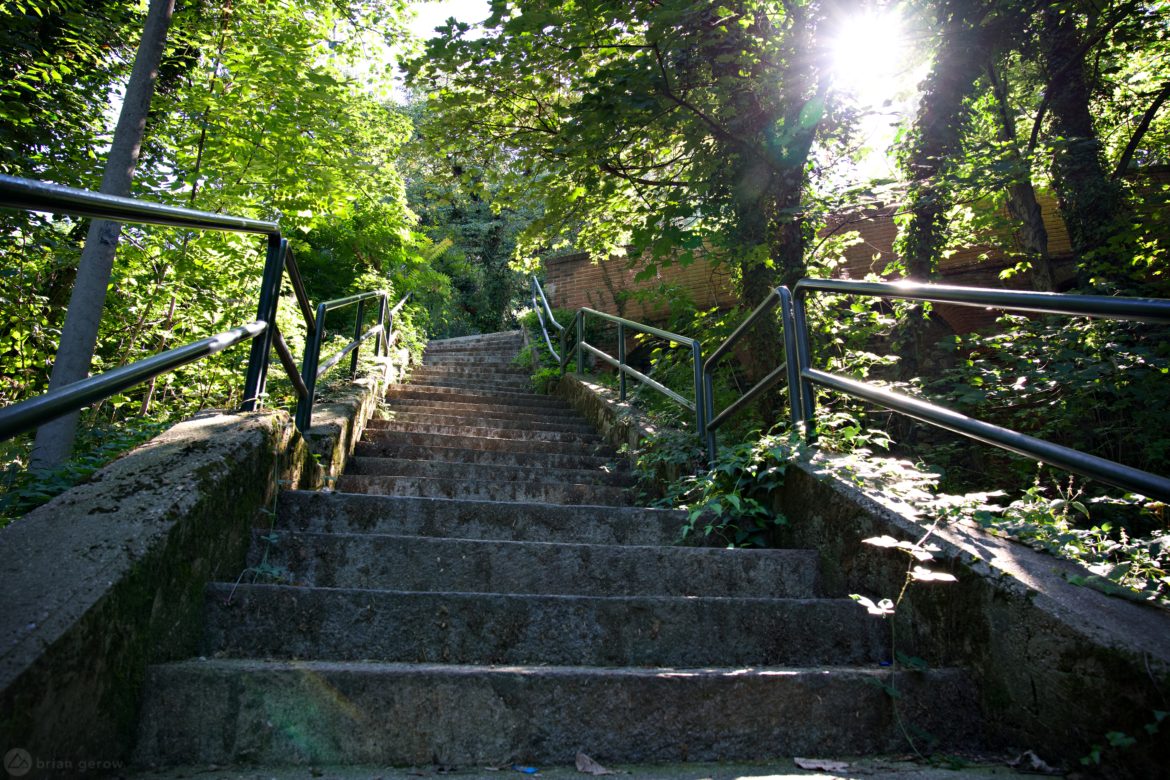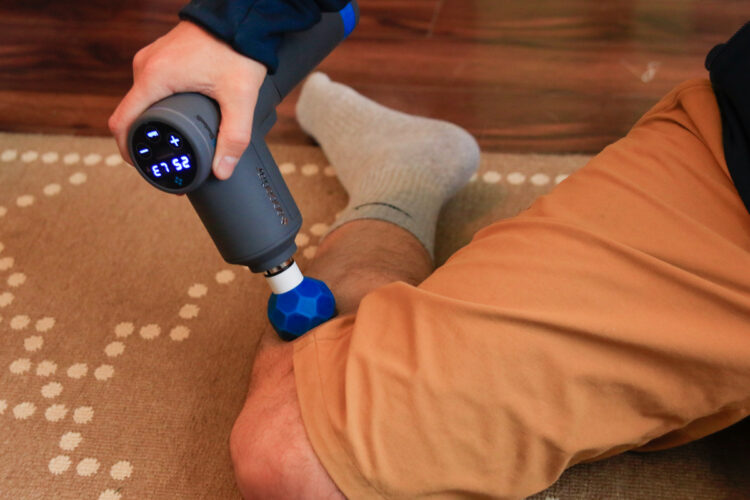
Author’s note: Three Deep Breaths is a column wherein I highlight research on mental health as it relates to mountain biking. While I aim to continue with stories of the fantastic mental health work folks are doing throughout our sport, I wanted to share my personal mental health struggle that some riders might connect with. As the title denotes, It began with a crash that was both a result of and contributor to my fragile mental health.
I was on a lunch ride in the cypress-scented hills above Florence, Italy. My daily loop consists of a forested singletrack climb, interspersed with quiet asphalt and dirt roads. Upon reaching the Catholic cross that marks nearly every peak on the Italian peninsula, I squeezed the sweat from my helmet and proceeded to hurl myself toward the singletrack descent with nervous urgency. Like every run down this track, my aim was to improve my overall time between the trailhead and the road below.
Roughly two-thirds of the way down the hill, the trail crosses a slippery section of stone. It’s the sort of rock that’s free of dirt, jutting from the earth in full blue-grey wholeness for 30 meters in both width and breadth. The rock’s surface is crowded with wheel gulping holes and drops that needed to be ridden precisely, or slowly.
At the time I was experiencing a bout of the debilitating depression that has submerged large segments of my adult life. My mind was concerned with all sorts of things other than the rocks I was throwing it at. Riding trails was the only thing that felt good at the time, and I was riding every day.
On this particularly distracted pass over the massive boulder, I misjudged the line and my front wheel planted in one of the gaping holes. My body was tossed to the ground, and in a feeble effort to catch myself, I broke my hand. Fortunately, there was a paved road next to the trail, so I walked out to the road where I could pedal to the hospital to meet my partner for X-rays and a plaster cast — and eventually post-ride beers. I had broken several ribs in the past, but this was my first experience with a fracture that might keep me off the trail. It was a “boxer-break,” and like a fledgling boxer, my mind was aswim with fear.
I was wrenching in a bike shop at the time and had to quit my job since I couldn’t grip anything with my dominant left hand. I could see the truth before me, that the depression I was managing had just been fed some of its favorite snacks and would surely consume me next. A couple of days later, in lieu of that heavily approaching wave, I soaked the cast in the shower, cut it off with some craft scissors, and went on a two-day road bike tour with my partner and a dear friend. I had to ride largely one-handed, which was awkward, but it handily beat my known alternatives.
A month or so went by and I was cleared to ride on the road again, which I was stubbornly doing all along. My job at the bike shop had been filled, so I started looking for freelance writing gigs and revamped my personal blog. Alongside riding dirt, writing has always been a vital component of my mental health story.
One afternoon, roughly 45 days after the boxer-break, I decided it was time to ride the trail where I had snapped my hand. I rode easy, as I could feel the tender state of the bones beneath my skin. On a flat piece of trail, at a reasonable speed, I understeered and crashed again. This time I hit the ground even harder than the last, and I couldn’t lift my right arm. Once again I sauntered out to the road and pedaled down to the emergency room where they gave me a sling and some medicine to prevent clotting in my now immobile arm.
In this second dirtnap, the head of my humerus bone split in a v-shape, likely due to the tendons that attach to the bone pulling on it violently as my arm attempted to slow the fall. Now I was in real trouble. There was no way to ride with this break and I would have to find stairs to run for endorphins and stimulating books to pass the time. The doctors recommended surgery to pull the bone back together, and to ensure a full range of motion for my shoulder in the future. When they said that surgery would add several months of rehab to my recovery time, I opted for the shorter route back to my bike, and the bone remains in its broken state today.

Over the next several months I developed a regular routine of stair running, lunges, box jumps, and any other exercise I could find to maintain some happy brain chemicals. I read a lot, wrote more, and fought like hell against the Noonday Demon inside my head. This struggle was likely as trying for my family as it was for me, and I love them greatly for their resolute support and kindness.
A few years have passed since that crash, and I am in a far better place thanks entirely to my community, and some life-altering alternative mental health practices. I am back to riding nearly every day, but now I do so because I love it, not because I need it.
The most frustrating element of this return to the trail has been the unreasonable level of fear I experience while riding. When I first hopped back on the bike I would walk any piece of trail that required a decisive line choice, and I rode everything far slower than I wanted to. This seemed like the normal way of things, though today several elements of that fear continue to hinder my ability to fully enjoy a ride. I now ride most things that a tire can stick to and can let go of the brakes more often than not, but I have yet to relocate the flow-state that made me feel fused with the trail and the larger surrounding forest. That state of euphoria always appeared when I had nothing in my mind beyond the feel of the trail and the rich mountain air in my lungs. That was the magic that sparked my enduring crush on mountain biking, and I miss it like hot sun rays in December.
Akin to the slow march back to riding fast, I believe that the flow will click again someday. In the meantime, I will continue to frighten and challenge myself on the bike in every way I can manage, and focus all of my senses on the immediate trail ahead.






















7 Comments
Sep 23, 2019
Sep 23, 2019
The other part of finding flow is to detach yourself from your thoughts and be in the present. My thoughts are like the weather. Sometimes it's sunny and sometimes it's raining but the weather is always happening. My thoughts are sometimes dark and sometimes loving and they are also always happening. I don't think I can turn them off but I have learned to ignore them and be fully present. It's like the hum of a refrigerator. It's always running but do you even notice. You've got to stop attaching meaning to your thoughts.
When riding, stop attaching meaning to how you're riding. If you're going slow or have to walk a section, it doesn't mean anything. If you're riding fast and cleaning everything easily, it doesn't mean anything. Stop comparing how you're riding to how you think you should be riding or how you could ride in the past or how other people ride or how much better you ride than everyone else. Stop "trying" to ride better, faster, harder. Just ride. All that trying and comparing are just thoughts that should be ignored.
If you can distance yourself from your thoughts and obtain some fitness, I think most people can find flow. However, you can't find flow by "trying" to find flow. Tune out that yapping dog that you call your thoughts and put in the time to develop some fitness and flow will find you. I suspect that flow was a normal state for our hunter gatherer ancestors.
Sep 26, 2019
Sep 23, 2019
Sep 23, 2019
I have found flow through meditation off the bike, that lead to meditation on the bike. Learning to set everything aside took practice, and it will again. In my experience, the best way to find flow has been to find it in myself first.
Sep 27, 2019
Page reloaded. All lost.
Right it elsewhere folks - then paste.
:(
Sep 23, 2019